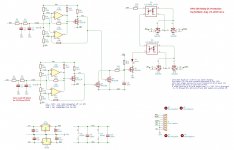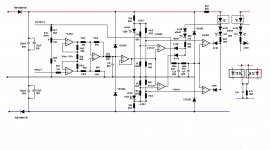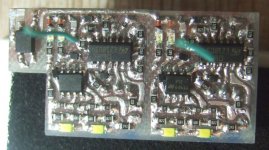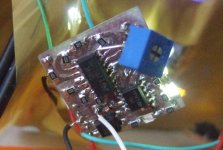To summarize, from a purely thermal POV, 500mJ should generally be safe enough.
Mechanical effects would depend very much on the construction and are not easily predictable.
Electrically, the 2J were unable to affect it: it stayed at 30 ohm.
Mechanically even 1J is a massive amount to dump into something delicate, its the energy in dropping 1kg weight 4 inches, or 100g (small apple) a whole meter onto the target!
Of course the efficiency of the driver may be low and mitigate this (in other words the vast majority of energy may end up thermal, not mechanical).
The full Thiele-Small parameter set may be useful for estimating voicecoil velocities for a pulse input, perhaps?
I'm surprised that I didn't find that thread when searching the forum for protection circuits. It's a good (long) read. ( I wonder why they banned Esperado ).
The ultimate protection IS comparing input and output . But I'm not that keen on some things in Esperado's circuit , and to implement it to a smaller HPamp .
The mosfets instead of a slower relay is a good way to get over the 5ms relay time , but I'm not that keen on using it . Even the fast output enable of an OPA1622 needs a relay to be 100 % sure .
I'm still going to pursue the InAmp idea , but it's going to be on the back burner . Since the output of any of the DC protectors is the same , I can build it as an extra little module that I can switch if it's not working well .
Well , more than a year further and I have some experience with these kind of DC
detectors. First I made a test circuit with the inamp , and it performed ok but not
100 % like I hoped . The object is still to have the best protection for expensive
HP's and to be sure , I decided to make and use both DC detectors . The Jhofland
type of DC protection (see post #8) for low level , but slower DC detection and the
faster Inamp in/out comparator for bigger DC's .
First the Jhofland type with double RCRC.
Mine not exactly like on that schematic . Because mine triggers a SR flipflop , no
hysteresis needed , and different trigger levels which has a disavantage , also his on
2 x 5 V mine 2 x 15 V. Plugging in a source via HP jack such as a computer or
mp3 player output with the HPamp on , triggers the SR flipflop. Also the thump
when switching the mp3 player on and off or even touching the contacts on the
jack , triggers. Now I know why Jhofland type uses a clever hysteresis instead of a flipflop. A timer could be used also. The Jhofland switches at about 0,56 V and
through hysteresis back at 0 V ! (if I calculated right) . This is clever and deletes
the need for a timer ( or a reset with a FF) at events I just mentioned , thumps are
just a short time and it engages the relay automatically after the "event" .
What I don't like is 2 x 5 V : in case of a serious fault , a voltage higher than 5 V
can be on the LM393's inputs and at power down with a higher voltage on the last
cap of the RCRC , can damage the LM's input . I feed them with the same voltage
as the HPamp, after a diode, AND put 2 protection diodes.
Another thing I don't like is the 560mV threshold , this is way too high for a HP DC
detector using 32 ohm HP's , maybe ok for 300 ohm ones. Of course it will be not
as sensitive and be more tolerant of thumps/pops and in/out plugging.
Some mentioned the RCRC is slower than 1 RC , but speed for me is not that
important here (because of the fast inamp type) and with 1 RC , the AC of large
low frequencies is too high. A second RC reduces this low freq AC a lot so not to
trigger when you have a lower threshold.
So I kept the double RC , no hysteresis , higher voltage supply , protection diodes
and for me a lower threshold of 100mV. Mine does trigger a SR flipflop which was
already build on the control PCB with an easy accesseble reset button.
This type is also easy to test , with a trimmer like a servo , it's easy to inject an
offset at the input x the amp's gain to get > 100mV on the output to make the
LM393 comparator switch. Although the threshold accuracy is not that important I
used white LED's as reference (2,52V) for both comparators, these cost nothing and give an indication that the divider works and the power is ok.
detectors. First I made a test circuit with the inamp , and it performed ok but not
100 % like I hoped . The object is still to have the best protection for expensive
HP's and to be sure , I decided to make and use both DC detectors . The Jhofland
type of DC protection (see post #8) for low level , but slower DC detection and the
faster Inamp in/out comparator for bigger DC's .
First the Jhofland type with double RCRC.
Mine not exactly like on that schematic . Because mine triggers a SR flipflop , no
hysteresis needed , and different trigger levels which has a disavantage , also his on
2 x 5 V mine 2 x 15 V. Plugging in a source via HP jack such as a computer or
mp3 player output with the HPamp on , triggers the SR flipflop. Also the thump
when switching the mp3 player on and off or even touching the contacts on the
jack , triggers. Now I know why Jhofland type uses a clever hysteresis instead of a flipflop. A timer could be used also. The Jhofland switches at about 0,56 V and
through hysteresis back at 0 V ! (if I calculated right) . This is clever and deletes
the need for a timer ( or a reset with a FF) at events I just mentioned , thumps are
just a short time and it engages the relay automatically after the "event" .
What I don't like is 2 x 5 V : in case of a serious fault , a voltage higher than 5 V
can be on the LM393's inputs and at power down with a higher voltage on the last
cap of the RCRC , can damage the LM's input . I feed them with the same voltage
as the HPamp, after a diode, AND put 2 protection diodes.
Another thing I don't like is the 560mV threshold , this is way too high for a HP DC
detector using 32 ohm HP's , maybe ok for 300 ohm ones. Of course it will be not
as sensitive and be more tolerant of thumps/pops and in/out plugging.
Some mentioned the RCRC is slower than 1 RC , but speed for me is not that
important here (because of the fast inamp type) and with 1 RC , the AC of large
low frequencies is too high. A second RC reduces this low freq AC a lot so not to
trigger when you have a lower threshold.
So I kept the double RC , no hysteresis , higher voltage supply , protection diodes
and for me a lower threshold of 100mV. Mine does trigger a SR flipflop which was
already build on the control PCB with an easy accesseble reset button.
This type is also easy to test , with a trimmer like a servo , it's easy to inject an
offset at the input x the amp's gain to get > 100mV on the output to make the
LM393 comparator switch. Although the threshold accuracy is not that important I
used white LED's as reference (2,52V) for both comparators, these cost nothing and give an indication that the divider works and the power is ok.
Attachments
The InAmp type .
Despite the comments here against InAmps, I still wanted a fast one , comparing in
and output , as a second protector but less sensitive and for higher voltages. Both
circuits together consume about 2mA per channel and cost near to nothing , so why
not ? (TL064 & LM393 are cheap and low power but still fast enough, no need for
more expensive and performant opamps like OPA4197-OPA4196).
Low gain (9,3x) , means low offset (-14 and -9 mVdc) and low AC on the output
of TL064 and less sensitive as not to get false triggering with normal signals.
I wanted it triggered for a difference of 250mVdc between input and output .
The 100 ohm trimmer is for adjusting the R-divider to match the amp's gain (here
5,6 x), important with bigger Inamp gains ( which I used with the test circuit) , to
get as low ac on the opamps output .
Harder to test because injected offset on the input will be the same on the output .
It worked with the test circuit and feeding it voltages above the compartors
thresholds so with a signal it should do the same. The red LED's give an indication
which circuit triggers the FF through the same optocoupler , but because of the
RCRC the Jhofland type will keep the LED longer on at a small event like a thump
from switching source on/off.
The Inamp reacts to the same events as described above and also to distortion
when the mp3 player is full volume . The HPamp is a test amp with only 1 NE5532
with 2 opamps parallel , barely able to drive a 32 ohm HP at that point so the
distortion triggers and maybe it is because the HP is way over its head (overdriven)
and causes the output to differ from input.
Normally with quality sources there won't be pops/thumps and you don't have to
connect/disconnect sources while the HPamp is on , so the triggering will not
happen . Also my good HP is on cinch plugs , no HP jack so when it gets pulled
out it won't short the output which may cause a trigger if there is a signal on the
output. Of course it is my choice to have a SR flipflop which needs a reset after an
event , a timer could do that automaticaly or large enough hysteresis like the
Jhofland type.
Practically , the switching off of the relay is a nuisance when there are thumps/pops
from the source's on/off , pluging in/out of the input jack ( because computer and ,
mp3 only have HP jacks ) . But that relay switching on at startup with a signal
already from the source is the biggest nuisance . Maybe my thresholds are too low
and I should use the high 560mV as the Jhofland type and higher for after the
InAmp.
Despite the comments here against InAmps, I still wanted a fast one , comparing in
and output , as a second protector but less sensitive and for higher voltages. Both
circuits together consume about 2mA per channel and cost near to nothing , so why
not ? (TL064 & LM393 are cheap and low power but still fast enough, no need for
more expensive and performant opamps like OPA4197-OPA4196).
Low gain (9,3x) , means low offset (-14 and -9 mVdc) and low AC on the output
of TL064 and less sensitive as not to get false triggering with normal signals.
I wanted it triggered for a difference of 250mVdc between input and output .
The 100 ohm trimmer is for adjusting the R-divider to match the amp's gain (here
5,6 x), important with bigger Inamp gains ( which I used with the test circuit) , to
get as low ac on the opamps output .
Harder to test because injected offset on the input will be the same on the output .
It worked with the test circuit and feeding it voltages above the compartors
thresholds so with a signal it should do the same. The red LED's give an indication
which circuit triggers the FF through the same optocoupler , but because of the
RCRC the Jhofland type will keep the LED longer on at a small event like a thump
from switching source on/off.
The Inamp reacts to the same events as described above and also to distortion
when the mp3 player is full volume . The HPamp is a test amp with only 1 NE5532
with 2 opamps parallel , barely able to drive a 32 ohm HP at that point so the
distortion triggers and maybe it is because the HP is way over its head (overdriven)
and causes the output to differ from input.
Normally with quality sources there won't be pops/thumps and you don't have to
connect/disconnect sources while the HPamp is on , so the triggering will not
happen . Also my good HP is on cinch plugs , no HP jack so when it gets pulled
out it won't short the output which may cause a trigger if there is a signal on the
output. Of course it is my choice to have a SR flipflop which needs a reset after an
event , a timer could do that automaticaly or large enough hysteresis like the
Jhofland type.
Practically , the switching off of the relay is a nuisance when there are thumps/pops
from the source's on/off , pluging in/out of the input jack ( because computer and ,
mp3 only have HP jacks ) . But that relay switching on at startup with a signal
already from the source is the biggest nuisance . Maybe my thresholds are too low
and I should use the high 560mV as the Jhofland type and higher for after the
InAmp.
Attachments
Last edited:
- Status
- This old topic is closed. If you want to reopen this topic, contact a moderator using the "Report Post" button.



